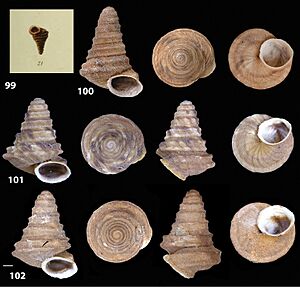Wollastonaria turricula facts for kids
Quick facts for kids Wollastonaria turricula |
|
|---|---|
 |
|
| Shell of Wollastonaria turricula | |
| Conservation status | |
| Scientific classification | |
| Synonyms | |
|
Wollastonaria turricula is a tiny, air-breathing land snail. It's a type of mollusk that lives on land, belonging to the family Geomitridae.
This special snail is found only in the Madeira archipelago, specifically on a small island called Ilhéu de Cima.
What Does It Look Like?
The shell of the Wollastonaria turricula snail is quite unique. It's shaped a bit like a flat discus or a lens, with a sharp edge all around its spirals, which are called whorls.
You can easily tell it apart from other similar snails because of its "peculiarly turreted shell." This means its shell has a distinct, tower-like shape.
Where Does It Live?
This snail, sometimes called Hystricella turricula, lives only on the coastal slopes and flat areas of Ilhéu de Cima. This small island is located off the southeastern coast of Porto Santo.
You can find these snails hiding under volcanic rocks and other bits of debris in open fields. There's also a local type, called pererosa, that lives on steep slopes closer to the sea.
Scientists have found them in places like the southwestern coast of Ilhéu de Cima, about 40 meters high. They've also been found at the very top of Ilhéu de Cima, around 100 meters high, under stones.
Why Is It Important?
The Wollastonaria turricula snail is listed in Annex IV of the Habitats Directive. This is a special rule that helps protect certain animals and plants in Europe.
Scientists believe this snail is Critically Endangered. This means it's at a very high risk of disappearing forever. The area where it lives is less than 1 square kilometer (about 0.4 square miles).
The snail is in danger because of animals grazing in its habitat and other unknown reasons. Its numbers have dropped a lot, and it now only lives in one small area on a high plateau. Protecting this tiny snail helps keep the natural world healthy.


